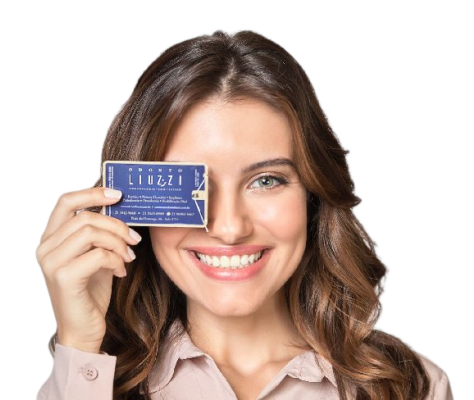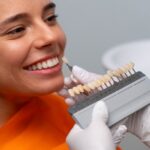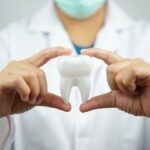When considering dental treatments such as dental veneers, many doubts and misconceptions arise regarding the tooth wear during treatment and on materials used, such as porcelain and resin.
In this blog, we will unravel the myths and clarify the truth behind the wear and tear associated with this procedure. Check out!
Myths about wear and tear
It is a myth to say that, when undergoing treatment with dental veneers, there will be a lot of wear on the teeth, especially with porcelain veneers compared to resin veneers. In reality, the wear on teeth when applying veneers is not linked to the material or the professional, but rather to the final expectation of the procedure and mainly, to the position of the tooth initially.
Read: Dental Veneers: Why a Personalized Consultation is Vital to Your Choice.
Initial position of the teeth
When considering tooth wear for veneers, the initial position of the teeth plays a crucial role. For example, a tooth that is tilted forward may require grinding to align its position before the procedure.
Without adequate wear, the tooth will become even more inclined, affecting the harmony and aesthetics expected from this treatment and will certainly be a case of failure and regret.
Excessive wear x orthodontic aligner
In situations where excessive wear is a risk due to the initial position of the tooth, a viable alternative may be to opt for orthodontic treatment, such as the use of aligners.
Prior alignment of teeth with the help of orthodontic aligners can reduce the need for excessive wear to apply veneers.
When seeking the correct alignment of teeth before veneer treatment, orthodontic aligners can be a more conservative solution, avoiding unnecessary wear. Although they require more time to complete the treatment, it will also preserve the tooth structure and guarantee a more satisfactory and lasting result.
It is essential to discuss with your dentist the best options for achieving your desired results, taking into consideration your long-term dental health and treatment expectations.
Professional assessment will help determine the best path to a harmonious and satisfactory smile, avoiding excessive wear and promoting aesthetic and functional results.
Crucial factors for tooth wear
Occlusion Adjustment: In some cases, to ensure a correct bite, minimal wear on the teeth may be necessary before applying veneers.
Teeth Alignment: To correct gaps or misalignments, slight grinding may be required to allow for ideal fit of the veneers, in some cases the alternative orthodontic aligner may be indicated.
Aesthetics and Functionality Guarantee: In situations where it is essential to achieve a perfect aesthetic and functional result, minimal wear may be recommended to improve the fit of the veneers.
Position and Individual Need: Wear varies depending on the position and specific needs of each tooth, regardless of the material chosen for the veneers.
Material Thickness: resin veneers They generally require more thickness to guarantee the necessary resistance, which may require greater wear than porcelain veneers.
Dental Veneers: Porcelain vs. Resin
It is essential to understand that tooth wear when applying veneers is not determined by the material chosen, but rather by the need for adjustment and position of the tooth. Resin veneers may, in some cases, require greater wear, as they require a greater thickness to ensure ideal resistance, unlike porcelain veneers, which have superior properties in this aspect, and guarantee durability even in thin layers such as dental contact lenses.
When unraveling the myths and truths about wear related to dental veneers, it becomes clear that the procedure is not simply limited to the material chosen, but rather to the specific clinical needs of each patient.
The final expectation of treatment and the initial position of the tooth are crucial factors in determining the wear required to apply veneers.
Grinding is a potentially vital step in achieving an aesthetically and functionally balanced smile. For example, correcting a tooth that is tilted forward may require prior grinding to ensure aesthetic harmony and avoid unsatisfactory results.
Conservative alternatives for cases of excessive wear
In cases where excessive wear is a concern, more conservative alternatives, such as treatment with orthodontic aligners, may be considered. Although they may require more time, and sometimes more money, these methods preserve tooth structure and contribute to long-lasting and satisfactory results.
Don't forget: The dentist will know what the best options are
It is essential to discuss the best options with your dentist, considering long-term oral health and individual treatment expectations. A detailed professional assessment will help determine the ideal path to achieving a harmonious smile, avoiding excessive wear and promoting ideal aesthetic and functional results.
Remember, each case is unique
When seeking to understand the best options for your treatment, contact qualified professionals, such as Odontoliuzzi, for precise and personalized guidance, aimed at the health and beauty of your smile.
Your informed decisions will lead to satisfying, long-lasting results, giving you a confident, radiant smile.










 per
per